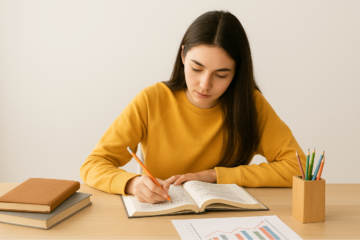Create the perfect environment for focus, learning, and success!
A new academic year brings a fresh start, new goals, and plenty of motivation to do better than before. One of the best ways to kickstart your journey toward academic success is by setting up a dedicated, organized, and inspiring study space. A well-arranged study area helps students concentrate better, manage time more efficiently, and enjoy the learning process.
In this blog, we’ll explore how students (especially from 2nd to 8th grade) can design a study space that supports better focus, creativity, and consistent study habits.
Why a Study Space Matters
Before we start organizing, let’s understand why a study space is important. When students study in a quiet, clutter-free area, their minds become more focused. The brain gets trained to know: “This is my study zone, and now it’s time to work.”
Having a study spot also helps reduce distractions, saves time looking for school supplies, and makes it easier to stay in a routine. Whether it’s a full desk or a corner on the table, any child can benefit from a defined learning space.
Step 1: Choose the Right Spot
Pick a spot in your home that’s:
- Quiet – away from the TV, kitchen, or loud areas.
- Well-lit – natural sunlight is best, but a desk lamp works too.
- Comfortable – but not too cozy like a bed or couch.
Tip: Try to use the same place every day so your brain links that space to “study time.”
Step 2: Keep It Clean and Organized
A cluttered desk = a cluttered mind. Remove toys, extra gadgets, and old papers. Keep only what’s needed, such as:
- Textbooks and notebooks
- Pencils, pens, erasers
- A small board or notepad for quick notes
- Ruler, sharpener, and basic stationery
You can use jars, small boxes, or even trays to sort things neatly. Label drawers or boxes to make it easier for kids to find what they need.
Step 3: Personalize It
Make the study space feel exciting and comfortable by adding personal touches. Kids love their own style, so let them decorate a bit! Some ideas include:
- A motivational quote or poster
- A cute calendar to mark exam days or holidays
- Their favorite cartoon stickers (but not too many!)
- A small plant or soft toy for company
When students feel happy in their study corner, they’re more likely to stick to their routine.
Step 4: Good Lighting is a Must
Studying in poor light strains the eyes. If possible, place the desk near a window for natural light. If the room is dark, a small desk lamp with soft white light helps keep the space bright without hurting the eyes.
Extra tip: Avoid using harsh white tube lights or study in direct sunlight—it can be uncomfortable for long hours.
Step 5: Sit Right – Choose the Right Furniture
Kids between 2nd to 8th standard should sit on a chair that supports their back and keeps their feet flat on the floor. The table should be at elbow height so they can write without bending too much.
No need for expensive furniture—a simple table and a chair with cushions can work if arranged properly.
Step 6: Keep Distractions Away
Remove items that distract—mobiles, tablets, toys, and noisy gadgets should be kept out of reach during study time. Even if the child is using online material, try using it in supervision and for a limited time.
Helpful idea: Have a small “tech basket” where all gadgets go during study time.
Step 7: Add a Timetable or Routine Board
Use a small whiteboard or paper chart to write down the day’s study tasks. Kids can tick off tasks after completing them. This builds discipline and gives them a sense of achievement.
For younger students (classes 2 to 5), parents can help write:
- 20 minutes for reading
- 15 minutes for maths practice
- Homework time
- Breaks or drawing time
Older students (classes 6 to 8) can manage more subjects, so they can break it up by:
- Subject-wise slots
- Chapter revision time
- Doubt-clearing session
- Mini mock test time
Step 8: Keep Supplies Within Reach
Make sure everything your child needs is close by:
- Pens, pencils, erasers
- Color pencils for diagrams
- Geometry box (for older classes)
- Water bottle, tissues, and a snack (if needed)
This helps reduce excuses like “I forgot my pencil” or “I need to get my ruler,” which often break the flow of study.
Step 9: Use a Noticeboard (Optional)
A small corkboard or chart paper pinned to the wall can help:
- Stick important dates (test or school events)
- Pin helpful diagrams or reminders
- Post goals for the week or month
This visual aid helps children stay on track and teaches planning skills.
Step 10: Encourage Consistency
Remind children to use their study space every day—even for 20 minutes. Slowly, it becomes a habit, and studying won’t feel like a burden. The more regular the use, the better the results!
Extra Tips for Parents:
- Keep the study area free from loud background sounds.
- Check their posture while sitting.
- Give gentle reminders about using the space daily.
- Encourage short breaks between long study sessions.
Benefits of a Good Study Space
Here’s what happens when students have a study space they love:
- Better focus and fewer distractions
- Improved handwriting and note-taking
- Time saved searching for things
- Regular study habits form naturally
- Children become more responsible and independent
Conclusion: Your Space, Your Success!
A well-set study space is like a magic corner where children can think, learn, and grow. Whether it’s a full desk or a simple setup on the floor, what matters most is that it’s used with care and discipline. Let the new school year be a fresh start—not just with books, but with the right environment that supports your child’s success.
“Your study space is your personal launchpad—organize it well, and your learning will fly high!”




